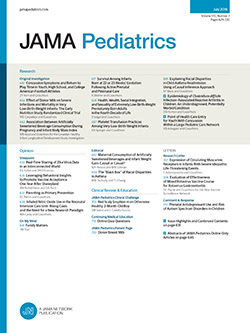Efficacy and Safety of GLP-1 RAs in Children and Adolescents With Obesity or Type 2 Diabetes: A Systematic Review and Meta-Analysis.
IF 18
1区 医学
Q1 PEDIATRICS
引用次数: 0
Abstract
Importance Obesity affects 1 in 5 children and adolescents, increasing the risk of type 2 diabetes (T2D). Glucagon-like peptide-1 receptor agonists (GLP-1 RAs) are among the few pharmacotherapy options available for this population, necessitating a comprehensive evaluation of efficacy and safety. Objective To assess the efficacy and safety of GLP-1 RAs in children and adolescents (<18 years) with obesity, prediabetes, or T2D. Data Sources A systematic search was conducted in PubMed, Embase, and the Cochrane Central Register of Controlled Trials (CENTRAL) for randomized clinical trials (RCTs) published from inception until February 28, 2025. Data analysis was completed from January 2025 to April 2025. Study Selection RCTs comparing GLP-1 RAs to placebo in children and adolescents with obesity, overweight, prediabetes, or T2D with reported safety and efficacy data were included. Data Extraction and Synthesis Two reviewers independently extracted data on sample size, population, interventions, follow-up, and outcomes. Risk of bias was assessed using version 2 of the Cochrane risk of bias tool (RoB2). Efficacy outcomes (except lipids) were analyzed as estimated treatment differences, lipids as estimated treatment ratios, and safety via rate ratios. A random-effects inverse variance model was used for all outcomes. Main Outcomes and Measures The primary efficacy outcomes were change in hemoglobin A1c (HbA1c) (in percentage points), fasting glucose (in milligrams per deciliter), body weight (in kilograms), body mass index (BMI, calculated as weight in kilograms divided by height in meters squared), BMI z scores or percentiles, BMI standard deviation score (SDS), lipid outcomes, and blood pressure. Exploratory efficacy outcomes included obstructive sleep apnea and metabolic dysfunction-associated steatohepatitis or metabolic dysfunction-associated steatotic liver disease. Safety outcomes included gastrointestinal adverse effects (GI AEs), infections, hepatobiliary disorders, suicidal ideation or behaviors, depression, hypoglycemia, and adverse event discontinuations. Results A total of 18 RCTs (11 in obesity, 6 in T2D, and 1 in prediabetes) with 1402 participants (838 GLP-1 RA users and 564 placebo) were included (mean [range] age, 13.7 [6-17] years; 831 female participants (59.3%); median [IQR] treatment duration, 0.51 [0.25-1.00] years). GLP-1 RAs significantly reduced HbA1c (-0.44%; 95% CI, -0.68% to -0.21%), fasting glucose (-9.92 mg/dL; 95% CI, -16.20 to -3.64), body weight (-3.02 kg; 95% CI, -4.98 to -1.06), BMI (-1.45; 95% CI, -2.40 to -0.49), BMI SDS (-0.20; 95% CI, -0.36 to -0.05), BMI percentile (-7.24%; 95% CI, -12.97% to -1.51%), and systolic blood pressure (-2.73 mm Hg; 95% CI, -4.04 to -1.43) and increased GI AE (log[rate ratio] [RR], 0.75). Other AEs, including suicidal ideation or behaviors, showed no significant differences. Conclusions and Relevance In this systematic review and meta-analysis of 18 trials, GLP-1 RAs significantly improved glycemic, weight, and cardiometabolic outcomes in children and adolescents with T2D or obesity. Available data over a relatively short follow-up suggested suicidal ideation or behaviors were not significantly different, although GI AEs warrant attention in long-term management.GLP-1 RAs治疗儿童和青少年肥胖或2型糖尿病的疗效和安全性:一项系统综述和荟萃分析
重要性肥胖影响五分之一的儿童和青少年,增加了2型糖尿病(T2D)的风险。胰高血糖素样肽-1受体激动剂(GLP-1 RAs)是为数不多的可用于该人群的药物治疗选择之一,需要对其疗效和安全性进行全面评估。目的评价GLP-1 RAs在儿童和青少年(<18岁)肥胖、前驱糖尿病或T2D患者中的疗效和安全性。数据来源系统检索PubMed、Embase和Cochrane Central Register of Controlled Trials (Central),检索从开始到2025年2月28日发表的随机临床试验(rct)。数据分析于2025年1月至2025年4月完成。研究选择纳入比较GLP-1 RAs与安慰剂在患有肥胖、超重、前驱糖尿病或T2D的儿童和青少年中的疗效和安全性数据的随机对照试验。数据提取和综合两名审稿人独立提取了样本量、人群、干预措施、随访和结果方面的数据。使用Cochraneⅱ版偏倚风险工具(RoB2)评估偏倚风险。疗效结果(脂质除外)以估计治疗差异、脂质作为估计治疗比率和安全性通过率比率进行分析。所有结果均采用随机效应反方差模型。主要疗效指标为血红蛋白A1c (HbA1c)(以百分点计)、空腹血糖(以毫克/分升计)、体重(以公斤计)、体重指数(BMI,以体重(公斤)除以身高(米)的平方计算)、BMI z评分或百分位数、BMI标准差评分(SDS)、脂质结局和血压的变化。探索性疗效结果包括阻塞性睡眠呼吸暂停和代谢功能障碍相关的脂肪性肝炎或代谢功能障碍相关的脂肪性肝病。安全性结局包括胃肠道不良反应(GI ae)、感染、肝胆功能障碍、自杀意念或行为、抑郁、低血糖和不良事件停药。结果共纳入18项随机对照试验(11项肥胖、6项T2D和1项前驱糖尿病),1402名参与者(838名GLP-1 RA使用者和564名安慰剂)(平均[范围]年龄13.7[6-17]岁,831名女性参与者(59.3%);中位[IQR]治疗时间为0.51[0.25-1.00]年)。GLP-1 RAs显著降低HbA1c (-0.44%, 95% CI, -0.68%至-0.21%)、空腹血糖(-9.92 mg/dL, 95% CI, -16.20至-3.64)、体重(-3.02 kg, 95% CI, -4.98至-1.06)、BMI (-1.45, 95% CI, -2.40至-0.49)、BMI SDS (-0.20, 95% CI, -0.36至-0.05)、BMI百分位数(-7.24%,95% CI, -12.97%至-1.51%)、收缩压(-2.73 mmhg, 95% CI, -4.04至-1.43)和GI AE (log[rate ratio] [RR], 0.75)。其他ae,包括自杀意念或行为,没有显着差异。结论和相关性:在18项试验的系统回顾和荟萃分析中,GLP-1 RAs可显著改善儿童和青少年T2D或肥胖患者的血糖、体重和心脏代谢结局。在相对较短的随访中,现有数据表明自杀意念或行为没有显著差异,尽管GI ae需要长期管理。
本文章由计算机程序翻译,如有差异,请以英文原文为准。
求助全文
约1分钟内获得全文
求助全文
来源期刊

JAMA Pediatrics
PEDIATRICS-
CiteScore
31.60
自引率
1.90%
发文量
357
期刊介绍:
JAMA Pediatrics, the oldest continuously published pediatric journal in the US since 1911, is an international peer-reviewed publication and a part of the JAMA Network. Published weekly online and in 12 issues annually, it garners over 8.4 million article views and downloads yearly. All research articles become freely accessible online after 12 months without any author fees, and through the WHO's HINARI program, the online version is accessible to institutions in developing countries.
With a focus on advancing the health of infants, children, and adolescents, JAMA Pediatrics serves as a platform for discussing crucial issues and policies in child and adolescent health care. Leveraging the latest technology, it ensures timely access to information for its readers worldwide.
 求助内容:
求助内容: 应助结果提醒方式:
应助结果提醒方式:


